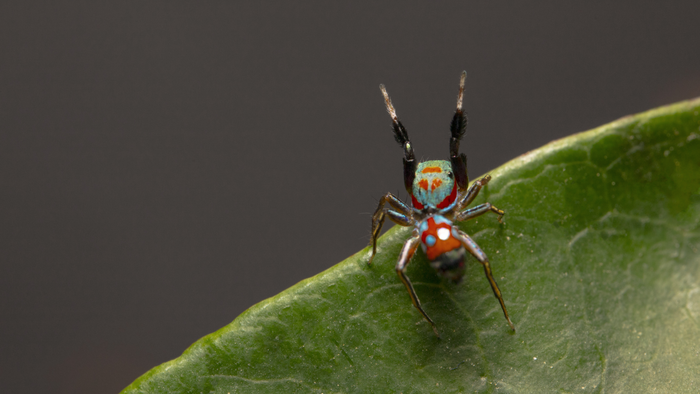Surprisingly-bad acting is key to jumping spider's survival
A tiny jumping spider's imperfect ant impression lets it mimic multiple species, enabling it to live in various habitats.

Scientists have discovered the survival secret of a brightly colored spider that mimics ants to deter predators: the imperfection of its impressions.
The tiny jumping spider Siler collingwoodi lifts its front legs to form mock antennae while swinging its legs and jiggling its abdomen to copy an ant's gait. Ants often possess spiny defenses and venomous jaws, so the spider's act is intended to discourage potential predators that may be more wary of an ant.
Now, a new study reveals that S. collingwoodi's impersonation is far from perfect — but that its imperfect performance is no bad thing, enabling the amateur performer to mimic multiple ant species and deter most of its predators. The researchers published their findings May 17 in the journal iScience.
Related: Bold jumping spiders can literally go blind with hunger
"S. collingwoodi is not necessarily a perfect mimic, because its gait and trajectory showed high similarity with multiple ant species," study first author Hua Zeng, an ecologist at Peking University, said in a statement. "Being a general mimic rather than perfectly mimicking one ant species could benefit the spiders by allowing them to expand their range if the ant models occupy different habitats."
To investigate how the ant-mimicking spider fools its predators, the researchers collected S. collingwoodi along with five ant species and another type of non-mimicking jumping spider from four locations across southern China's Hainan island. By comparing S. collingwoodi's ant impersonations to the movements of real ants, the researchers found that the spider's gait was a good all-around impersonation of all of them and most closely resembled the gaits of the three smaller ant species that were closer to its size. The non-mimicking spider, in comparison, showed no resemblance to the ants.
The true test came with how S. collingwoodi's performance was received by its harshest critics: two of its likely predators, the praying mantis Gonypeta brunneri and the predatory jumping spider Portia labiata, which is similar in size to S. collingwoodi. The mantis was unconvinced by S. collingwoodi's thespian bobbling and snacked on it, as well as the non-mimicking spider.
Get the world’s most fascinating discoveries delivered straight to your inbox.
However, the predatory spider did not attack the spider mimic — a sign that its performance does work on some occasions and is possibly most effective at deterring predators that are less willing and capable of fending off an ant's counterattack.
But this thespian spider doesn't rely on its acting abilities alone: Another layer to the spider's defenses is its costume — the brilliant flecks of metallic oranges, reds and blues that mark its head and abdomen. The researchers modeled these patterns with the known visual systems of the mantis and predatory spider, along with two plants — the Chinese Ixora (Ixora chinensis) and the Fukien tea tree (Carmona microphylla) — that S. collingwoodi lives on. These plants helped camouflage the mimic spider, with the jasmine plant successfully hiding it from both predators.
In a follow-up investigation, the researchers said they will investigate whether the spider's performance is genetic or acquired by learning — which will reveal even more about the dancing spider's usefully imperfect display.

Ben Turner is a U.K. based writer and editor at Live Science. He covers physics and astronomy, tech and climate change. He graduated from University College London with a degree in particle physics before training as a journalist. When he's not writing, Ben enjoys reading literature, playing the guitar and embarrassing himself with chess.
 Live Science Plus
Live Science Plus





